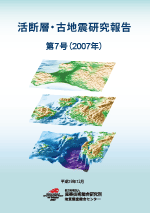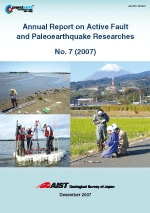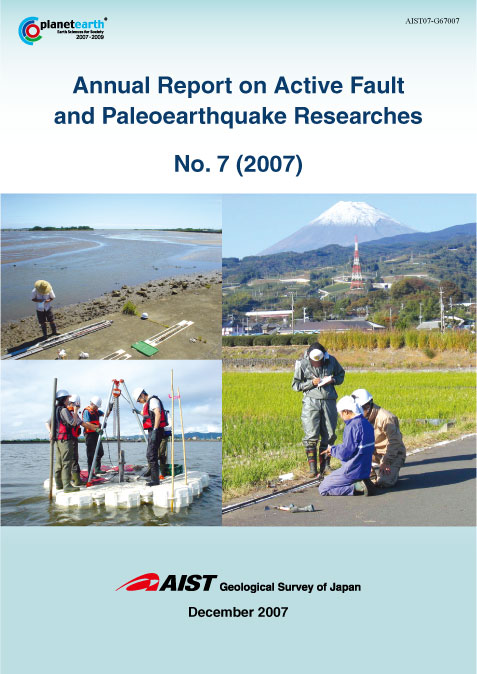Active Fault and Paleoearthquake Researches No. 7 (2007)
Cover |
Back cover |
Back cover
Survey of prehistoric subduction zone earthquakes.
Subduction zone earthquakes cause coastal movement or leave tsunami deposits in coastal zone, hence surveys of these geologic records will reveal history of prehistoric earthquakes.
Left: Survey of the Torino-umi lagoon (Sawai et al., pages 47-80). The lagoon bottom is widely emerged during low tide (top), but submerged during high tide (bottom). Sedimentary sequences were reconstructed from cored samples and crustal movement and tsunami deposits were examined.
Right: Survey of Ukishima lowland, east of Fujigawa river (Fujiwara et al, pages 91-118; Komatsubara et al., pages 119-128). The lowland on the Philippine Sea Plate is expected to have been subsided repeatedly by the activity of the Fijigawa-koako fault zone. Past crustal movements have been investigated in the sedimentary sequences under paddy fields.

Geological Survey of Japan, AIST
- About GSJ
- Our Activities
- Purchase guide
-
Publications and Database
- information
- Bulletin of the Geological Survey of Japan
- bull2025(Vol.76)
- bull2024(Vol.75)
- bull2023(Vol.74)
- bull2022(Vol.73)
- bull2021(Vol.72)
- bull2020(Vol.71)
- bull2019(Vol.70)
- bull2018(Vol.69)
- bull2017(Vol.68)
- bull2016(Vol.67)
- bull2015(Vol.66)
- bull2014(Vol.65)
- bull2013(Vol.64)
- bull2012(Vol.63)
- bull2011(Vol.62)
- bull2010(Vol.61)
- bull2009(Vol.60)
- bull2008(Vol.59)
- bull2007(Vol.58)
- bull2006(Vol.57)
- bull2005(Vol.56)
- bull2004(Vol.55)
- bull2003(Vol.54)
- bull2002(Vol.53)
- bull2001(Vol.52)
- Bulletin of the Geological Survey of Japan(old)
- Annual Report on Active Fault and Paleoearthquake Researches
- Reports, Geological Survey of Japan
- CCOP-GSJ Groundwater Project Report
- CCOP Technical Bulletin
- Cruise Report
- Geological Hazards
- Learning and Education
- GSJ Database Collection
- Collection of links

